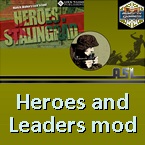asl3d
Posts: 6531
Joined: 2/6/2017
Status: offline

|
Marines
In World War II, the Marines performed a central role in the Pacific War, along with the U.S. Army. The battles of Guadalcanal, Bougainville, Tarawa, Guam, Tinian, Cape Gloucester, Saipan, Peleliu, Iwo Jima, and Okinawa saw fierce fighting between Marines and the Imperial Japanese Army. Some 600,000 Americans served in the U.S. Marine Corps in World War II. The Battle of Iwo Jima, which began on 19 February 1945, was arguably the most famous Marine engagement of the war. The Japanese had learned from their defeats in the Marianas Campaign and prepared many fortified positions on the island including pillboxes and network of tunnels. The Japanese put up fierce resistance, but American forces reached the summit of Mount Suribachi on 23 February. The mission was accomplished with high losses of 26,000 American casualties and 22,000 Japanese.
By the end of the war, the Corps expanded from two brigades to six divisions, five air wings, and supporting troops, totaling about 485,000 Marines. In addition, 20 defense battalions and a parachute battalion were raised.[59] Nearly 87,000 Marines were casualties during World War II (including nearly 20,000 killed), and 82 were awarded the Medal of Honor. Despite Secretary of the Navy, James Forrestal's prediction that the Marine flag raising at Iwo Jima meant "a Marine Corps for the next five hundred years", the Corps faced an immediate institutional crisis following the war due to a suddenly shrunken budget. Army generals pushing for a strengthened and reorganized defense establishment attempted to fold the Marine mission and assets into the Navy and Army. Drawing on hastily assembled Congressional support, and with the assistance of the so-called "Revolt of the Admirals", the Marine Corps rebuffed such efforts to dismantle the Corps, resulting in statutory protection of the Marine Corps in the National Security Act of 1947. Shortly afterward, in 1952 the Douglas–Mansfield Act afforded the Commandant an equal voice with the Joint Chiefs of Staff on matters relating to the Marines and established the structure of three active divisions and air wings that remain today

 Attachment (1) Attachment (1)
< Message edited by asl3d -- 11/4/2020 6:08:52 PM >
_____________________________
Semper fidelis
|
 Printable Version
Printable Version





































 New Messages
New Messages No New Messages
No New Messages Hot Topic w/ New Messages
Hot Topic w/ New Messages Hot Topic w/o New Messages
Hot Topic w/o New Messages Locked w/ New Messages
Locked w/ New Messages Locked w/o New Messages
Locked w/o New Messages Post New Thread
Post New Thread